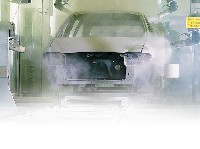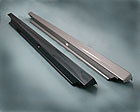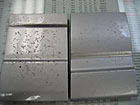Durakon and Soliant - Changing an Automotive Model

Durakon and Soliant are changing an automotive industry model with cost-effective high-volume thermoformed paint film parts. For almost 40 years, the accepted industry model stated that injection molding and painting was the best method for high-volume automotive plastic parts. “We’re breaking the mold,” said Ed Gniewek, president and CEO of Durakon, one of the world’s largest thermoformers. Together, both companies are creating a new standard for automotive plastic parts with Class A finishes that are more durable than conventional paint, better for the environment, and offer more value to automakers and consumers.
Thermoforming with Soliant Fluorex® paint film is an effective choice for automotive plastic parts requiring a Class A finish for a number of reasons. Automakers get better quality while achieving major cost saving and greater environmental stewardship by using thermoforming with paint film for high-volume plastic parts.
OEMs are specifying paint film instead of conventional paint on parts requiring high- wear resistance, such as stone guards, rocker panels, fascias and running boards. Durakon is thermoforming 250,000 rocker panels a year for GM’s Buick Lucerne with Soliant Fluorex paint film in 14 different colors, including metallics and pearlescents.
Other high-volume Durakon thermoformed part programs with Fluorex paint film include:
- Saab front-end fascias;
- Jeep Liberty Renegade fascias; and
- Cadillac STS-V rocker panels.
Thermoforming Advantages
Paint Film Performance
Laboratory
tests and field tests prove that paint film is more durable, more chip
resistant (see gravelometer test photo) and weather resistant than conventional
paint. This gives automakers more value and fewer warranty issues, further
enhancing the cost effectiveness of thermoformed paint film parts.
“A part with paint film is more beautiful than a painted part – the DOI (Distinctness-of-Image) is impeccable. It looks like wet glass – it’s that good! If you hold a painted part next to a part with Soliant Fluorex paint film you’ll see how much more beautiful it is,” challenges Len Damico, vice president OEM Sales at Durakon. “It doesn’t have the orange peel frequently seen with paint.”

Paint Film Drives Cost Saves
Many value propositions exist by combining thermoforming with Fluorex paint film technology. Automakers save a step in the manufacturing process as the part is finished right out of the mold. This cost save is multiplied exponentially in new plants, as there is no need to install or maintain a painting facility, which can be millions of dollars. Further cost saves result, as there are also no environmental compliance issues. No VOCs are released when thermoforming paint film parts, thus making it an environmentally friendly, sustainable technology.Award-Winning Technology
Soliant won the Environmental Award in the “Emerging Technologies” category at SPE-GPEC 2006 (Society of Plastics Engineers – Global Plastics Environmental Conference), for its paint film process. Soliant demonstrated a 98% reduction in VOC emissions based on an analysis of the production and use of its product compared to traditional vehicle painting. As a frame of reference, this means that if paint film were used on just five million cars per year, the VOC reduction would be equivalent to eliminating current emissions of Atlanta and several other similar sized cities. Soliant met all GPEC Award Criteria, including leadership in plastics and the environment, generating significant economic value and creating new markets (paint alternatives) that will benefit the environment and the quality of life.
Thermoforming Advantages in High-Volume Production
Thermoforming has always been the plastic process of choice for most short-run production programs. Today the process is becoming cost-effective in high-volume applications as well. This paradigm shift is because the thermoforming process itself offers additional advantages over injection molding. One advantage is that there are tonnage restrictions with injection molding and not with thermoforming. Almost any size part can be thermoformed.Better Resins for Thermoforming
“Resin suppliers are paying more attention to thermoforming and producing a greater variety of materials today, offering varying quality characteristics that can be thermoformed but not injection molded,” said Ed Gniewek. “There are more additives and subgroups of materials for optimum processing.” The injection molding process requires that plastic be pushed through the mold so it requires resin material that flows easily, such as polypropylene, but it may not be the best material to meet the part performance requirements. Thermoforming will work with a greater variety of resin characteristics than injection molding and blow molding. This allows thermoformers to give customers more quality solutions across a number of applications.
Faster to Market
Tooling costs with thermoforming can be 50% less than injection molding and blow molding tooling costs. The time from concept to production is also much less than what injection molding is. Injection molders take 24-26 weeks on average to do what Durakon can do in 10-12 weeks. It takes less than half the amount of time to develop a part with thermoforming than injection molding. This can be critical to product launch schedules. Cycle times with thermoforming are fast. Durakon can process most parts, from part to part, in less than a minute. That includes robotic trimming, pack and ship.Looking Forward
Will Paint Film Replace Paint?
“Every
car company we know has an objective to get rid of paint – eventually,” said Ed
Gniewek. “Painting is just becoming environmentally unfriendly – very messy –
very dirty,” adds Len Damico. “Within 10 years, the major automakers will not
be painting – having an entire vehicle of plastic paint film is very likely,”
continues Gniewek.
Durakon thermoformed parts with Fluorex paint film are being considered for
military vehicles and other off-road vehicles requiring durable body panels. As
applications for parts with Fluorex paint film continue to provide added value,
greater durability and environmental benefits, it begs the question: Is the
paradigm shifting further toward entire vehicle surfaces in Soliant Fluorex
paint film?

Bright Future
“Everyone wants chrome!” exclaims Gniewek. “Soliant’s Fluorex bright film will gain traction even faster than its paint film.” Fluorex bright film, a paint film that mimics chrome, is the solution for automakers wanting to differentiate their vehicles with a chrome style. According to an exhibitor at the 2006 SPE Thermoforming Conference and Expo, “Soliant’s Fluorex bright film is the most sought after product in the industry.”For more information, contact John Cupstid, marketing director, Soliant, 803/313.8222 or Len Damico, VP OEM Sales, Durakon, 249/324.0118.
Looking for a reprint of this article?
From high-res PDFs to custom plaques, order your copy today!



